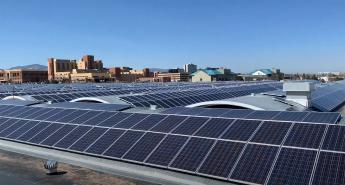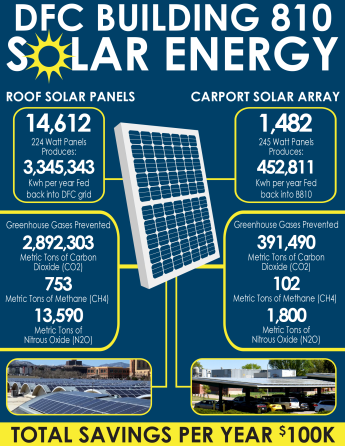Sun, Savings and Climate Change: How Region 8 Uses Solar Power
By Richard Stebbins

GSA strives to support green energy in our federal buildings to promote energy efficiency, create greater climate risk resiliency and to reduce our reliance on fossil fuels that emit greenhouse gas emissions which drive climate change.
At the Denver Federal Center (DFC), photovoltaic solar power is being used to provide a sustainable energy source but it also has a secondary effect at reducing greenhouse gases.
"Our Building 810 (B810) has the largest roof space on the campus, so in 2010 we installed solar panels that cover a majority of the area," said Jamie Whiles, Community Business Center Manager. "We also installed solar panels on the carports in 2011."
More than 14,000 224 watt solar panels were installed on the roof and 1,400 225 watt panels were installed on the carports. The roof panels produce 3,345,343 kWh of electrical energy per year that is fed back into the DFC. The carport panels produce 452,811 kWh per year just for B810.
Using solar power is not just about how much energy is produced, it is also about how much greenhouse gases (GHG) are prevented.
The prevention of GHG just from B810 is substantial:
- 2,892,303 metric tons of carbon dioxide
- 753 metric tons of methane
- 13,590 metric tons of nitrous oxide
From the carport, the prevention of GHG was also impressive:
- 391,490 metric tons of carbon dioxide
- 102 metric tons of methane
- 1,800 metric tons of nitrous oxide
The prevention of this amount of GHG is equivalent to taking more than 1.7 million passenger cars off the road each year per EPA equivalency calculations.
"We have calculated an estimate of a total savings of more than $100,000 per year in energy costs based on the production of the 15,000 plus solar panels just at B810 for 2020", said Whiles.
The DFC was an early adopter of photovoltaic technology, building three solar parks and installing photovoltaic (PV) panels on three building rooftops and four carports across the campus. The PV systems combined produce approximately 22 percent of the DFC's electrical power requirements.
You can read more about how solar power helps save Region 8 money and about other sustainability in our We Are Green series.

 U.S. General Services Administration
U.S. General Services Administration
